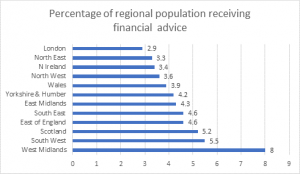intelliflo, a leading software provider for financial advisers in the UK, has introduced today its first-ever ‘Advice Map of Britain.’
Based on intelliflo’s data from three million financial advisers’ clients, the Advice Map of Britain reveals how widely advice is accessed, and found that engagement with financial advice varies considerably across age, relationship status, gender, and geographical location. The advice gaps highlighted in the data show that millions of people are not getting the help they need with their personal finances.
The age gap
People in their 50s are the most likely to receive advice, with data showing that a quarter (25%) of people receiving advice fall into this demographic. Second are those aged 60-69 (21%), and third, those aged 40-49 (16%). In comparison, people in their 30s represent 11% and under 30s represent just 5% of all people being advised across the UK. With life expectancy on the rise, financial planning has become more important than ever and the advice gap between younger and older people supports concerns that the young may find themselves with insufficient funds for retirement.
The relationship gap
When looking at relationship status, most people receiving advice are married or in a civil partnership (66%). In comparison, 23% of people receiving advice are single or cohabiting, meaning that single people are almost three times less likely to receive financial advice than people who are married. Furthermore, 6% of those receiving advice are divorced and 5% are widowed.
The gender gap
Across the UK, intelliflo’s data shows that 46% of people receiving professional advice on their finances are female and 54% are male. The North East has the largest gender advice gap, where the split between female and male advised clients is 44% to 56% respectively, whereas London has the narrowest gap of 48% females to 52% males.
The regional gap
Data also reveals the postcode hotspots where the greatest number of people are receiving financial advice. The top 10 postcodes (together making up 1.4% of the total sample size) are:
- SL6 – Slough
- IM2 – Isle of Man
- LE12 – Leicester
- BA2 – Bath
- PH1 – Perth
- IV2 – Inverness
- AB15 – Aberdeen
- CF14 – Cardiff
- AB51 – Aberdeen
- TQ12 – Torquay
When broken down regionally, the West Midlands (8%) is where the greatest proportion of the local population are receiving advice, according to intelliflo’s data, followed by the South West and Scotland. London has the fewest people proportionally benefitting from the value of advice.

Widening access to financial advice
With a heightened focus on personal finances brought on by the pandemic, there is greater urgency to widen access to advice – and close the advice gaps – than ever before.
Nick Eatock, CEO of intelliflo, comments: “Financial advice can make a positive difference to someone’s personal circumstances, especially during challenging economic times. Yet, we can see that engagement with financial advice varies quite considerably, whether that’s a result of where you live, your age or relationship status.”
He added: “We believe we’re facing a massive opportunity for change in 2021 driven by a rapid acceleration in the adoption of technology, which plays a vital part in reducing the cost of onboarding a new client and delivering advice to smaller savers. With 60% of advisers reporting better adoption of technology with their clients over the pandemic, I believe this will mark a turning point in the way that people are able to access and engage with financial advisers and receive the professional advice they need on complex financial matters.”
Nick Eatock shares the three ways technology is widening access to financial advice:
1. Technology lowers the cost of servicing clients:
By automating processes, advisers can increase their efficiency and lower costs. Research from intelliflo shows that, when comparing advisers adopting technology to its maximum potential with those who are not, the high adopters are earning on average 57% higher revenue. By reducing the cost of servicing clients, technology is enabling people to access advice at a lower cost than ever before.
2. Increasing the number of clients:
intelliflo’s research comparing low technology adopters with high adopters also shows that the latter are servicing 41% more clients using technology. Through technology, consumers can access advisers in a way that suits them – at home or face-to-face.
3. Servicing clients in new locations:
What’s more, technology is enabling advisers to reach clients in new geographical locations by supporting remote servicing, meaning people have a much wider choice and supply of advisers than ever before.
















